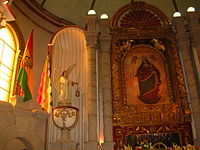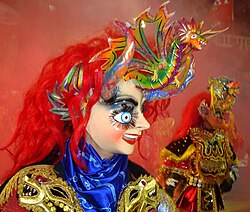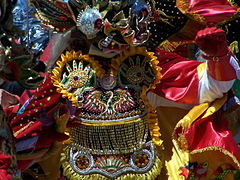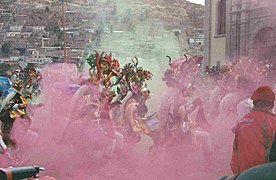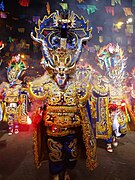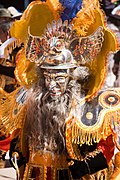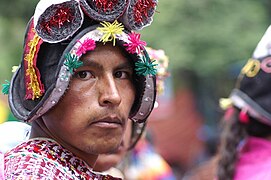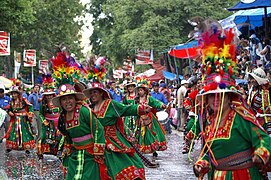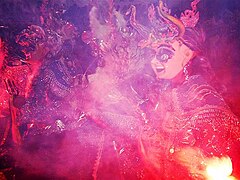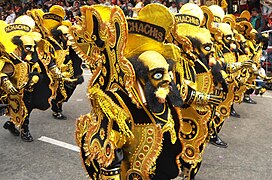Oruro's Carnival
The Oruro Carnival is a folkloric and cultural festivity in the city of Oruro, as well as the highest representation of carnivals in Bolivia, “Masterpiece of the Oral and Intangible Heritage of Humanity” (Unesco). Throughout the carnival, more than 50 folkloric ensembles participate, distributed in 18 dance specialties that come from different parts of Bolivia and who make their pilgrimage to the Socavón Sanctuary every Saturday of carnival in the traditional "Entrance". This celebration Due to the great popularity it has achieved in recent years and due to its great cultural manifestation and tourist attraction, it has become one of the most important carnivals together with that of Rio de Janeiro in Brazil, the Carnival of Barranquilla in Colombia and other carnivals. in the world. Around 400,000 people visit the carnival annually, generating an economic movement of at least 125 million Bolivians.
History
Pre-Hispanic period
The interculturality of the pre-Inca, pre-Hispanic, hunting, lacustrine, agricultural, highland cattle ranchers and other lowland peoples is presented. From remote times Jururu (Uru Uru), today Oruro was a center of religious pilgrimage in the Andean world, towards the sacred mountain range of the Urus, which had protective deities called Wakas, apus and achachilas, these deities were Jampatukollo (Sapo hill), Argentillo Arankani (lizard hill), the viper (Quwak), the condor and Wakallusta (Resbaladero de Ídolos) among others. After the conquest of the Inca Empire, they tried to introduce their religion by turning Wari into an evil demigod and the wakas or sacred Apus into plagues, petrified by the Inca Ñusta. Thus the urus had to worship only pachacamaj represented by Inti.[citation required]
The Spanish from the conquest and colonization during the Viceroyalty of Peru, produced a unique religious syncretism of transculturation with Huari (Wari), synthesized in the uncle who remained as the devil universal and together with the pachamama, the ñusta that became the virgin of the tunnel.
Colonial Period
It is expressed from the encounter during the Viceroyalty of Peru, of the western world (Spanish) with the native cultures of the region. The fact was generating its own social safeguard mechanisms that began in 1789 during the Viceroyalty of Peru when the Catholic Church officially enthroned the image of the Virgin Candelaria that is venerated within the Carnival festivity, hence the movable date. The miners They create the troupe of devils that would pay homage to the Virgen del Socavón on Carnival Saturdays, days they had off work in the mine.[citation required] By order of the Viceroy of Peru, the celebrations were prohibited throughout the 17th century, although they were maintained and revived by the original peoples under the Catholic rituals of the Fiesta de la Candelaria (or purification of the Virgin). Christian icons thus replaced native deities, with the exchange of saints for the minor elements of Inca cosmology. In 1818 the parish priest of Oruro, Ladislao Montealegre, wrote the work Narrative of the Seven Deadly Sins, for which, according to Harris and Fortún, elements of the Ball of Devils would have been presented. > Catalan as being the devil, which in the devil is called China Supay and where the devil leads the seven deadly sins in battle against the opposing virtues and an angel. Harris suggests that Montealegre may have wanted to represent the threat of the Oruro Rebellion and the historical context with this work.
Virgin of the Socavón
In 1559, at the request of Paria Paria's encomendero, Lorenzo de Aldana, the Augustinian friars came from Spain to the Viceroyalty of Peru and dedicated themselves to the evangelization of the Altiplano. Its first arrivals are in Challacollo, Paria, Toledo and Capinota this year. The Paria encomendero, Lorenzo de Aldana, had created a Mayorazgo or charitable foundation in favor of religion and the indigenous entrusted to him. Aldana died in 1573, ten years before Francisco Tito Yupanqui carved, in 1583, the Image of la Candelaria for the sanctuary of Copacabana during the Viceroyalty of Peru, also entrusted to the Augustinians in 1588. Aldana was born in 1508 in Extremadura, in the city of Cáceres, where devotion to the Virgin of Candelaria was great.
The Augustinians brought a strong Marian devotion from Spain to the Viceroyalty of Peru, where the Candelaria festival had already been established in the 11th century as one of the four main Marian festivals. Leaving Spain, they had touched as the last port, before crossing the ocean, Tenerife, in the Canary Islands, where there was a Sanctuary dedicated to the Virgen de la Candelaria. Hence the devotion to Candelaria “had become especially popular among sailors who took her as a lawyer and hoisted her next to the rudders on the stormy voyages to the Viceroyalty of Peru in America.
Independence and the transition to carnival
In Oruro there is a sanctuary in honor of the Virgen del Socavón, but this date was moved to the dates of the carnival in this city; this transition was a product of the Bolivian war of independence.
There is a legend that tells that during the Saturday of carnival in the year 1789 a bandit named Anselmo Bellarmino known as the Nina-Nina or Chiru-Chiru was mortally wounded in a street fight and before dying he was confronted by the Virgin of Candelaria. Some versions say that he used to worship a life-size image of the Virgin painted on a wall of an abandoned house, others say that this painting appeared miraculously in the bandit's house after his death, it is also said that the priest Carlos Borromeo Mantilla heard the confession of Anselmo Belardino who confessed to having kidnapped Lorenza Chuquiamo, in the confession he declared that he had been helped by a young woman who lit two candles on top of Pie de Gallo hill. This legend concludes with the story of a troop of devils dancing in honor of the Virgin during the following year's carnival. The sanctuary present in Oruro was completed by the year 1891.
However, according to Max Harris, Ph.D. in religious studies and executive director of the Wisconsin Humanities Council at the University of Wisconsin-Madison, this legend would be related to a historical reality. During the viceroyalty rebellion of Túpac Amaru II, Oruro experienced a brief but bloody revolution. During the night of Saturday, February 10, 1781, the Creole majority attacked the ruling minority made up of escutcheons or direct descendants of Spaniards born in the southern cone. With the arrival of the indigenous army, the criollos formed an alliance.
On February 15, a messenger arrived from Cuzco to Oruro with orders from Túpac Amaru II. He had instructed his army to respect the churches and the clergy, not to harm the Creoles, and only prosecute the escutcheons. He also ensured victory by entering La Paz & # 34; for Shrovetide & # 34;, the indigenous occupation of Oruro had begun to withdraw, leaving thousands of dead. But during March and April they launched more attacks on the city but this time against the criollos and the remaining Spanish who united forces to repel them.
Harris notes that the carnival of the year 1781 fell on February 24, placing the occupation of Oruro exactly between the Candelaria festival and carnival, rendering this situation in Harris's words "carnavalesca". Religious processions shared their space with secular, European and Creole parades disguising themselves as indigenous people, cases like that of a Spaniard disguised as a woman in a vain attempt to save his life and thousands of armed men in the streets of the colonial city. On February 19, the people in the city, despite the conflict, continued celebrating and during carnival, the city markets were full of thieves selling the looted gold and silver back to their owners or to the cholos and mestizos. By the year 1784 it was already customary to rejoice, dance, play and form comparsas for the Oruro carnival.
Harris considers that it is against this background that the legend of the Virgen del Socavón of 1789 appeared favoring the rebellion since the indigenous people venerated the Virgen de la Candelaria, while the escutcheons used to venerate the Virgen del Rosario. According to the beliefs of the revolutionaries, the Virgen del Socavón would have tolerated the indigenous deities or "demons" and, according to Harris, if the legend is correct, by 1790 Oruro miners would have moved the celebration of Candelaria to carnival and added indigenous gods, masked as Christian devils, to the festivities.
A generation later, in 1825, Bolivia achieved its independence from the Spanish Empire and its separation from the Viceroyalties of La Plata and Peru, the Oruro Carnival took on a new meaning for Oruro residents. Two of the diablada comparsas and the street from which the parade begins received their names in honor of Sebastián Pagador, one of the Creole heroes of the revolt. The main square that is on the carnival route to the sanctuary of the Virgen del Socavón is called Plaza 10 de febrero, recalling the date of the rebellion.
Post colonial or republican period
The most complex period where tolerance arises between faith, religions and creativity. The social and popular behavior of the time imposes a mentality of segregating and inquisitive conservatism since the colony, for this reason the cholos and Creoles organized in brotherhoods participate clandestinely and protected in anonymity by the mask, thus making their presence in this space and sacred time of the Indians uniting the rituals of the Andean man with the Catholic ones. The dances are discriminated against by the wealthy class of society, calling them “dances of the Indiada”, because only the indigenous or peasants danced them. Dances that are born as satire towards the Spaniards and their black slaves, who inhabited this region during the Viceroyalty of Peru and were participants in the Oruro Rebellion of 1781 where there were companies of Spaniards, mestizos, Creoles and blacks. After the warlike confrontation between Bolivia and Paraguay, a meeting of the man from the countryside with the man from the city is generated, from the man from the east, with those from the valley and those from the altiplano who are confused in a single trench and know beyond theirs the national reality, this historical event marked these classes and they took on a nationalist consciousness, the comparsas de diablos, comparsas de morenos and others, participants in the Oruro carnival, began to undergo a change in their name, the "Danzas de la Indiada" became they would call: Diablada, Morenada, flamerada, etc. These dances of the Orureña Indianda would be accepted by the majority of society, coexistence in the Chaco War made the cities take these cultural manifestations as their own, and began to create new groups of troupes showing organizational, creative will, contributing with their intellect to pay their devotion to the Virgen del Socavón in the Oruro Carnival.
News
The celebration takes place in the city of Oruro, which is considered the folkloric capital of Bolivia. In the Oruro carnival, pagan and Catholic religions still coexist in symbiosis, showing the world their unique religious syncretism. Three days before the pilgrimage Saturday to the sanctuary of the tunnel by the 52 groups, people visit the condor and a week later to the viper to the south of the city, the toad to the north and to the east the sandbanks (ants). The Oruro carnival starts from the rainy season structure of the altiplano (jallupacha) that begins with the November rituals related to the cult of the dead in Todo Santos (Next week the first carnival treat), a period that extends until February (Entrance pilgrimage to the Virgen del Socavón). According to Law 602 of the Republic of Bolivia, the organizers of the Oruro Carnival are: the Oruro Municipal Mayor's Office, the Association of Folklore Ensembles (A.C.F.O.) and the Departmental Committee of Ethnography and Folklore of Oruro. At present, the most important celebrations are centered in the Socavón Sanctuary. There are 18 dance specialties, with 52 folk ensembles registered with the A.C.F.O. The devotion of the dancers is so great for the Virgin of the Socavón or (Mamita Candelaria) that they arrive from different regions of the country, and make an extensive tour, upon arriving at the church the dancers enter the sanctuary on their knees and with tears in their eyes. the face asking a favor to the Virgin of Socavón and in gratitude they promise to dance for three consecutive years. Everything ends with two theatrical performances of Catholic works that focus one on the Spanish conquest and the other on the triumph of the Archangel Michael over the Devil.
Awards
- 1970 Oruro capital of the Folclore de Bolivia is declared by decree. Taken to law in 1984.
- 1994 A decree of the Bolivian government declares Patrona of the Bolivian folklore to the Virgin of the Socavón.[chuckles]required]
- 1995 The State of Bolivia recognizes the entrance of the Carnival of Oruro as a Cultural, Traditional, Artistic and Folklore Heritage Site, which shows the meaning of popular and traditional culture.[chuckles]required]
- 2001 The United Nations Educational, Scientific and Cultural Organization (Unesco) proclaims the Carnival of Oruro the Masterpiece of the Oral and Intangible Heritage of Humanity.
- 2008 The Carnival of Oruro is registered in the Representative List of the Intangible Cultural Heritage of Humanity.
- 2012 The Andean Parliament recognizes the importance of the Carnival of Oruro as "Intangible Patrimony of the Andean Community, expressed in its 48 folklore sets and in its 18 dance specialties".
World Heritage Site
An international jury of personalities, convened by the United Nations Educational, Scientific and Cultural Organization (Unesco), proclaimed the Oruro Carnival as a "Masterpiece of the Oral and Intangible Heritage of Humanity". On May 18, 2001, the proclamation was broadcast from Paris, France. The international jury was chaired by the writer Juan Goytisolo. The artistic, cultural, academic and governmental world was represented by the President of the Republic of Mali, Alpha Oumar Konare, the Kabaka of Uganda, His Majesty Ronald Muwenda Mutebi il, Princess Basma Bint Talal of Jordan, the Bolivian singer Zulma Yugar and the Mexican writer Carlos Fuentes.
For the application, UNESCO requested a folder with the information, which was prepared by the ACFO (Association of Folklore Ensembles of Oruro) headed by the president of this entity, Dr. Walter Zambrana Balladares, who was joined by a series of personalities between historians and intellectuals. This information was delivered to the Bolivian Ministry of Culture to later be sent to UNESCO. The Oruro carnival, being the conjunction of more than 28,000 dancers, nearly 10,000 musicians distributed in 150 bands, street dance with a stage full of more than 400,000 spectators from the country and foreigners almost four kilometers away, in a meeting unimaginable of boys, girls, women and men, who sing, dance and work, in honor of the Virgen del Socavón, Patron Saint of miners and Queen of Bolivian folklore. It became a center for the dissemination of dance and music for Diabladas, morenadas, caporales, tobas, tinkus, etc. and thus become a "Masterpiece of the Oral and Intangible Heritage of Humanity".
Dance specialties
The historical importance in which Oruro gravitated and its great cultural and religious influence make its carnival a natural setting that reflects the interculturality of the different areas of Bolivia within its 416 square miles.
- The Andean-Altiplastic zone of Bolivia on whose foot are the valleys called Yungas where the dances of the Negritos, the Saya and the Caporales come from. The dense population of this area where are the departments of Potosí, Oruro and part of the La Paz is rich in folklore and many of these dances participate in the Carnival of Oruro, among these dances are the brunette, the diablada, the Tinku, flamerada, kullawada, kallawayas, the doctors, Incas and kantus that live in time and space making all,
- The valley area occupied by the departments of Cochabamba and Chuquisaca, they were inspiring the Pujllay, the Potolos and the Salay.
- The plains and the jungles with the departments of Santa Cruz, Beni, Pando, Tarija and part of Chuquisaca come inspirations from the chunchos and tobas, warrior dances that involve other ethnic groups within.
- Diaper.
- Brunette.
- Tobas
- Caporales
- Tinkus
- Incas
- Callers.
- Kullawada
- Suri Sicuri
- Antawaras
- Ahuatiris
- Waca waca
- tarqueada
- Sicuriada
- Zampoñeros
- Awqui awqui
- Kantus
- Chamber
- Tundiquis
- Kallawayas
- Huititis (wititis)
- Jalq'as or jalkas
- Doctors
- Waca waka
- Inti Llajta
- Phujllay
- Negritos
- Saya Afro-Bolivia
- Miners
- Potolos
Bronze Bands
One of the characteristics of the Oruro Carnival is the existence of Bronze bands that accompany the dance of the fraternities, the bands have an exclusive event called the Band Festival that brings together the groups that participate in the party.
The bands feature elaborate uniforms, choreography, and arranging styles of popular music of the day. Among the best known are the Intercontinental Poopó gang, and the Paymaster gang.
Spectators, dancers and musicians
There is a great variety of people who contribute to the realization of the Oruro Carnival. However, the dancers who participate in this carnival range from 28,000 to 35,000. The musicians between 5,000 and 10,000. And the attendance of tourists is broken down in the following table.
| Year | Premises | Tourism
National | Tourism
Aliens | Total |
|---|---|---|---|---|
| 2014 | - | - | - | 362,000 |
| 2015 | - | - | - | 434.400 |
| 2016 | - | - | - | 343.977 |
| 2017 | - | - | - | 411.818 |
| 2018 | 212.980 | 109.895 | 20.550 | 343.425 |
| 2019 | 89.420 | 109.468 | 67,000 | 265.888 |
| 2020 | - | - | - | 257.093 |
| 2021 | - | - | - | 000.000* |
*Carnival was canceled due to the COVID-19 pandemic
Image gallery
Contenido relacionado
My intimate enemy
Do you know Joe Black?
Mithridates, King of Pontus


